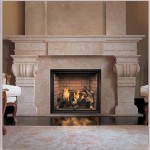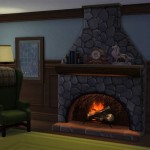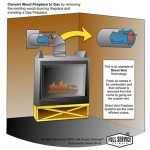Fireplace Hearth Ideas: Enhancing Style and Functionality
The fireplace hearth serves as a critical component of any fireplace design, blending functionality with aesthetic appeal. It acts as a protective barrier against sparks and embers, preventing damage to flooring and surrounding materials, while simultaneously contributing significantly to the overall décor of the room. Choosing the right hearth requires careful consideration of material, size, style, and safety regulations. This article will explore various hearth ideas, offering guidance on selecting the perfect hearth to complement a fireplace and enhance the living space.
Understanding the Purpose of a Fireplace Hearth
The fundamental purpose of a fireplace hearth is protection. Fireplaces, by their nature, involve combustion, and this process can generate sparks and embers that may escape the firebox. These stray particles can ignite flammable materials such as carpets, wooden floors, or furniture, leading to a fire hazard. The hearth, typically constructed from non-combustible materials like stone, brick, or tile, creates a safe zone around the fireplace, preventing the spread of fire.
Beyond its protective function, the hearth also serves as a visual anchor for the fireplace. It defines the space and draws attention to the fireplace as a focal point of the room. The design of the hearth can significantly impact the overall aesthetic, influencing the style, mood, and atmosphere of the living area. A well-chosen hearth can complement the fireplace surround, the room's décor, and the architectural style of the house.
Hearth size is dictated by building codes and safety regulations, which mandate specific minimum dimensions based on the type of fireplace and its fuel source. These regulations are in place to ensure adequate protection from stray embers. The dimensions usually refer to the distance the hearth extends beyond the firebox opening on all sides. Consulting local building codes is crucial before installing a fireplace or altering an existing hearth.
Exploring Different Hearth Materials
The selection of hearth materials is a crucial decision that impacts both the functionality and aesthetic appeal of the fireplace. Various materials offer different characteristics in terms of durability, heat resistance, maintenance requirements, and visual impact. Common hearth materials include stone, brick, tile, concrete, and metal.
Stone Hearths: Stone hearths are a popular choice due to their natural beauty, durability, and heat resistance. Options include granite, marble, slate, and limestone. Granite is known for its hardness and resistance to scratching and staining, making it a practical choice for high-traffic areas. Marble offers a luxurious and elegant look, but it is more porous and requires sealing to prevent staining. Slate provides a rustic and textured appearance, while limestone offers a softer, more muted tone. The cost of stone hearths can vary widely depending on the type of stone, its thickness, and its origin.
Brick Hearths: Brick hearths provide a classic and traditional look, often associated with warmth and comfort. Brick is a relatively affordable material and is highly durable and heat resistant. Brick can be laid in various patterns, such as herringbone, running bond, or basket weave, adding visual interest to the hearth. Brick can also be painted or stained to match the room's décor. However, brick is porous and may require sealing to prevent staining and moisture damage.
Tile Hearths: Tile hearths offer versatility in terms of design and color options. Tile can be made from ceramic, porcelain, or natural stone. Porcelain tile is known for its durability and resistance to moisture, making it a suitable choice for hearths. Ceramic tile is less expensive than porcelain but may not be as durable. Natural stone tile offers a unique and luxurious look but can be more expensive and require more maintenance. Tile can be arranged in countless patterns and designs, allowing for customization to suit any style of décor. Grout lines should be properly sealed to prevent staining and moisture penetration.
Concrete Hearths: Concrete hearths offer a modern and industrial aesthetic. Concrete can be poured in place or precast, allowing for flexibility in design and size. Concrete can be stained, polished, or stamped to create various textures and finishes. Concrete is durable and heat resistant, but it is also porous and requires sealing to prevent staining. Concrete hearths can be more expensive than other options, especially if custom designs are involved.
Metal Hearths: Metal hearths, typically made of steel or cast iron, offer a sleek and contemporary look. Metal is highly durable and heat resistant, making it a practical choice for modern fireplaces. Metal hearths can be powder-coated in various colors to match the room's décor. However, metal can become hot to the touch during fireplace use, so caution is advised. Metal hearths are often paired with gas fireplaces rather than wood-burning fireplaces.
Hearth Styles and Design Considerations
The style of the hearth should complement the overall design of the fireplace and the room. Various hearth styles can be employed to achieve different aesthetic effects. Common hearth styles include raised hearths, flush hearths, and extended hearths. The choice of style depends on personal preference, the architectural style of the house, and the functionality required.
Raised Hearths: Raised hearths are elevated above the floor level, typically by several inches to a foot or more. This style creates a more prominent focal point and can provide additional seating around the fireplace. Raised hearths can be constructed from various materials, such as stone, brick, or concrete. They often require structural support to bear the weight of the hearth and any occupants. Raised hearths can be particularly suitable for larger rooms with high ceilings.
Flush Hearths: Flush hearths are level with the surrounding floor, creating a seamless transition between the hearth and the flooring. This style is often preferred for minimalist or contemporary designs. Flush hearths can be constructed from tile, stone, or concrete. Proper installation is crucial to ensure a level and uniform surface. Flush hearths are less visually prominent than raised hearths but offer a clean and modern aesthetic.
Extended Hearths: Extended hearths extend beyond the fireplace surround, creating a larger protective area and providing additional space for decorative items or seating. Extended hearths can be constructed from various materials and can be designed in various shapes and sizes. They are particularly suitable for fireplaces that generate a lot of sparks or embers. Extended hearths can also serve as a transition area between the fireplace and the rest of the room.
In addition to the style of the hearth, several other design considerations should be taken into account. These include the color and texture of the hearth material, the shape and size of the hearth, and the overall proportion of the hearth relative to the fireplace and the room. The color of the hearth material should complement the fireplace surround and the room's décor. Lighter colors can create a brighter and more airy feel, while darker colors can add warmth and intimacy. The texture of the hearth material can also impact the overall aesthetic. Smooth textures create a more modern and refined look, while rough textures add a rustic and natural feel.
The shape and size of the hearth should be proportional to the fireplace and the room. A hearth that is too small may not provide adequate protection, while a hearth that is too large may overwhelm the space. The overall proportion of the hearth should be balanced and harmonious. The hearth should also be designed to accommodate any functional requirements, such as providing space for firewood storage or seating.
Safety and Building Codes
Safety should be the paramount concern when designing and installing a fireplace hearth. Building codes and safety regulations are in place to ensure that fireplaces are installed and operated safely, minimizing the risk of fire and carbon monoxide poisoning. Adhering to these regulations is crucial for the safety of occupants and the protection of property.
Local building codes typically specify minimum dimensions for hearths, based on the type of fireplace and its fuel source. These dimensions refer to the distance the hearth must extend beyond the firebox opening on all sides. The purpose of these regulations is to provide adequate protection from stray embers and sparks.
In addition to dimensional requirements, building codes may also specify the types of materials that can be used for hearth construction. Only non-combustible materials, such as stone, brick, tile, or concrete, are typically permitted. Wood or other flammable materials are not allowed in hearth construction.
Proper installation of the hearth is also crucial for safety. The hearth should be installed level and securely, with no gaps or cracks that could allow embers to escape. Grout lines should be properly sealed to prevent moisture penetration and staining. The hearth should also be inspected regularly for any signs of damage or deterioration.
For gas fireplaces, building codes may require the installation of a carbon monoxide detector in the vicinity of the fireplace. Carbon monoxide is a colorless and odorless gas that can be produced by incomplete combustion. A carbon monoxide detector can alert occupants to the presence of dangerous levels of carbon monoxide, allowing them to evacuate the premises and seek medical attention.
It is advisable to consult with a qualified contractor or building inspector to ensure that the fireplace and hearth are installed in accordance with all applicable building codes and safety regulations. This professional guidance can help to avoid costly mistakes and ensure the safety of the installation.

470 Best Hearths Ideas Front Room Home Living Log Burner

How To Decorate A Hearth Bhglivebetter Homedecor Homedecorideas Fireplace Decor Mantle
:strip_icc()/102009373-392cc981b3f743039e475f16b36a5c81.jpg?strip=all)
Best Fireplace Hearth Ideas And Designs Tips

Live Beautifully Before After A Beautiful Kitchen Home Fireplace Living Room

40 Fabulous Fireplace Design Ideas For Any Budget Or Style

Diy Fireplace Makeover At Home With The Barkers
5 Amazing Inexpensive Easy Fireplace Remodel Transformations Designed

Red Hot Fireplace Ideas

5 Fireplace Design Ideas That Will Enhance Your Home

35 Fireplace Mantel Ideas For A Heavenly Hearth








